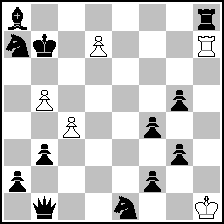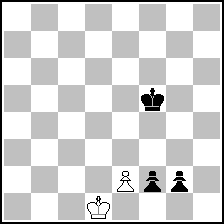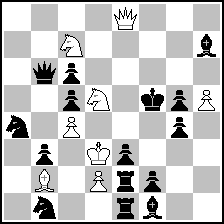
Website founded by
Milan Velimirović
in 2006
1:03 UTC


| |
MatPlus.Net  Forum Forum  Fairies Fairies  Exclusive Chess helpmate Exclusive Chess helpmate |
| |
|
|
|
|
You can only view this page!
| | | (1) Posted by Alex Levit [Friday, May 4, 2012 13:38]; edited by Alex Levit [12-05-06] | Exclusive Chess helpmate
Alex Levit, Original
 (= 5+12 ) (= 5+12 )
h#1.5*** Exclusive chess (5+12) C+
Exclusive: mate cannot be given if the side giving mate has more than one way of doing so.
Solution:
=======================================
Set:
2.Qc1 d8=B#! (d8=Q+? Rxh7#)
2.f3 d8=Q#! (d8=B/R+? Kb8/Kb6)
2.Sc8 dc8=S#! (d8=S+? Kb~+)
1...c5 2.g4 d8=R#! (d8=Q+? R(Q)xh7+)
Tries:
1...d8=Q(B)#??
1...c5 2.f3? d8=Q(R)#??
1...c5 2.Qc1? d8=B+? 3.K~8+
1...c5 2.Sc8? dc8=S+? 3.K~8+
=======================================
I think this one is not so easy to solve regardless of short solution. Exclusive logic can be very tricky!
Hope you enjoy it!
| | | (2) Posted by Alex Levit [Sunday, May 6, 2012 16:27] |
I have some questions about this composition.
1) Is the form of composition (h#1.5 - too short) bad or it's normal?
2) Is the form of solution (three set variation + one real solution) bad or it's OK?
Sorry if I paid too many attention to my problem.
| | | (3) Posted by Kevin Begley [Sunday, May 6, 2012 18:27]; edited by Kevin Begley [12-05-06] |
Very interesting problem idea!
As to your questions:
1) h#1.5 is not necessarily too short -- even if h#2 may be generally preferable, there are some excellent h#1.5 fairies, and
2) I see nothing inherently wrong with 3 setmates, and 1 solution -- in this specific instance, it seems good.
Whatever provides you the best opportunity for thematic analogy...
However, I must admit, this condition's need for a "recursive evaluation" may be difficult to fully appreciate, at present.
I first encountered the issue of "recursive evaluation" when investigating the Rex Multiplex condition (where a side is prevented from mating anything less than all of the opposing Kings).
I started looking for h=2 positions (with one or two other fairy elements) which could not be correctly evaluated without going to considerable depth (it wasn't so difficult to achieve extreme "recursive" depth, in a shallow problem).
I began to think I'd struck a gold mine for fairy chess exploration -- it offers possibilities unlike anything I had seen before (and, I see the same possibilities in your Exclusive Chess problem idea)...
But, I started encountering highly troubling situations (at least in Rex Multiplex -- I expect they would be possible in Exclusive Chess, as well)...
The deeper I'd mined for recursive prospects, the more I came into contact with alternative variations (some of these branches would bend into absolute insanity -- calling into question the very legality of my initial diagram!).
At the time, I took this as an indication that I was also standing on a retrgrade gold mine (completely neglecting the enormous challenges it presented).
I immediately turned my attention to uncovering what had already been shown in this condition.
After having encountered some Rex Multiplex problems marked as cooked in the Win Chloe database, I wound up having a conversation with Christian Poisson about this mater...
Christian was well aware of these issues, and if my memory serves, he was the first to inform me of the possibility (in Rex Multiplex, due to its need for "recursive evaluation") that some positions might be impossible to correctly evaluate (I think this was due to questions of retro-legality).
We also had a brief discussion about the challenge of programming computers to solve such problems -- I think it was at this point I first began to comprehend why such fairy conditions should not be considered ideal.
The more I investigated this, the more uncomfortable I grew about the need for deep recursive evaluations.
Ultimately, I decided this was no gold mine, but a Dimholt Road.
That's not to say it should not be explored... but, a journey down this path may require a very sharp instrument (to cut through the challenges that have kept the way shut).
I wish you continued luck in your explorations, but be warned: if you wander too far down this path, you may encounter unforeseen difficulties, which are not easily dismissed.
| | | (4) Posted by seetharaman kalyan [Sunday, May 6, 2012 23:18] |
The length seems fine. Even as H#1.5 , it took me long to understand what is happening !
Is this (Exclusive chess) a new invention of yours ?
| | | (5) Posted by Alex Levit [Sunday, May 6, 2012 23:58] |
Thanks for detailed answer Kevin! Fortunately Exclusive condition works correctly without any other condition and fairy pieces.
Just because mutual perpetual check is impossible. I believe that maximum recursive depth in "orthodox" case is 2.
For example:
 (= 8+6 ) (= 8+6 )
#1 Exclusive
So I hope that something interesting in this field can be found.
| | | (6) Posted by Alex Levit [Monday, May 7, 2012 00:34] |
@Seetharaman No! It's not my invention. This condition exist for 20 years at least. I think this one is not so popular but some brilliant problems exist.
I like this two:
Michel Caillaud, 1st Prize Probleemblad 1996
 (= 2+3 ) (= 2+3 )
h#5.5 2 Sol. Exclusive
1...Kd2 2.g1B Ke3 3.Bh2 Kf3 4.Be5 Kg2 5.Kf4 Kh2 6.f1Q e3#
1...e3 2.f1B Ke1 3.Bc4 Kf2 4.Be6 Kg3 5.g1Q+ Kh3 6.Qf2 e4#
Hubert Gockel, 2HM Problemist 1997. № 397 in CYCLONE
 (= 8+15 ) (= 8+15 )
#2 Exclusive
Set: 1...Qxc7 2.Qe4# 1...Sac3 2.Qe6# 1...cd5 2.Qe5#
1.Qxe3! (2.Se7#)
1...Qxc7 2.Qe6# 1...Sac3 2.Qe5# 1...cd5 2.Qe4#
| | | (7) Posted by Hauke Reddmann [Monday, May 7, 2012 10:49] |
@Alex - could you please elaborate in detail on the logic of your #1
example so that a poor #2 composer understands how it works? :-)
BTW, at least 53 consecutive checks are possible,
see Tim Krabbes site.
BTOW, need for recursive solving isn't new either, AFAIK.
Hauke
| | | (8) Posted by Alex Levit [Monday, May 7, 2012 11:14]; edited by Alex Levit [12-05-07] |
@Hauke Solution is 1.d4# specific checkmate. Moves 1...Qxd4#?? and Kb6#?? are specific checkmate itself hence illegal.
Why? Just because after 1...Qxd4# the only possible moves 2.Qdxd4# and 2.Qfxd4# are orthodox checkmate and still illegal.
Analogously after 1...Kb6# moves 2.Qdxc6# and 2.Qfxc6# are illegal. So we proof that after 1.d4# black has no legal defence.
And we can easily seen that 1.d4# is unique checkmate. Q.E.D.
P.S. BTW if we put white pawn on a5 then 1.d4+ is selfmate in 1. Funny twins!
| | | (9) Posted by Hauke Reddmann [Tuesday, May 8, 2012 14:29] |
D'oh, d4. Never considered THAT move :-)
OK, so the stipulation works analogous to "Ohneschach"
(check is illegal, unless it's mate) and it can recursively
be unwrapped from backwards as well. Understood. I immediately
construct you a position needing 3 recursions...
that is, when my head stops hurting :-)
Hauke
| |
No more posts |
MatPlus.Net  Forum Forum  Fairies Fairies  Exclusive Chess helpmate Exclusive Chess helpmate |
|
|
|
 ISC 2024
ISC 2024 Forum
Forum  Fairies
Fairies  Exclusive Chess helpmate
Exclusive Chess helpmate 


